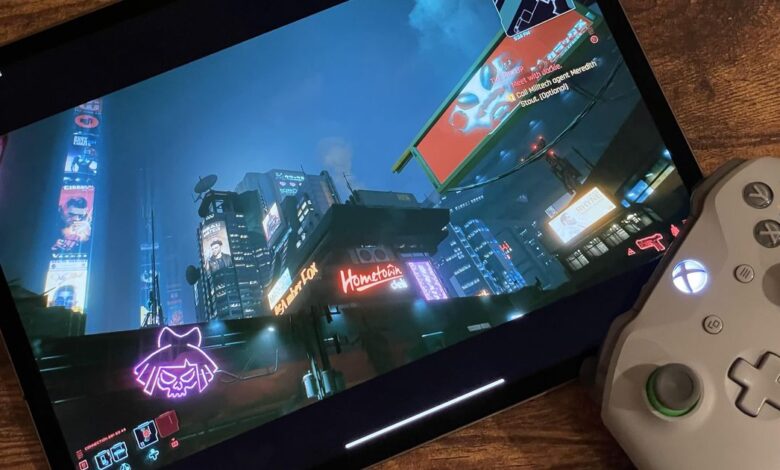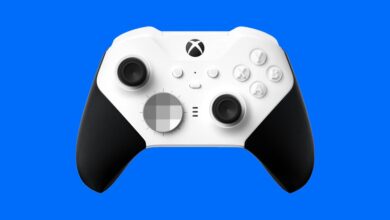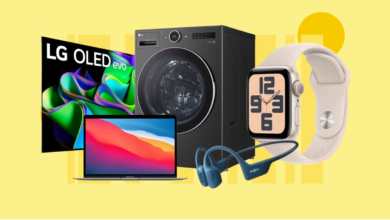5 reasons cloud gaming isn’t doing it for me — yet

Scott Stein/CNET
The best way to describe what we want cloud gaming to be — or how people think about it — is to compare it to the Netflix model. Games live on remote servers and stream to you in real time. But despite some of the biggest tech companies working on improving it, including Google, Amazon, Microsoft and Nvidia, it’s surprising to me that cloud gaming isn’t any better than it is right now.
Yes, some of it it’s caused by technology hurdles, like the need for constant, consistent two-way communication between your controller and the server-side game, making it a much more complex process than just binge-watching a streaming TV series. There are lag and delay issues, some of which come down to simple physics.
But there’s also an awful lot of unnecessary friction built into the apps, interfaces and game selection.

Stadia, on a big screen.
Sarah Tew/CNET
Dancing between devices
The best thing about Netflix, Amazon Prime Video, Apple TV, and others is that they work almost universally. On a TV, a laptop, an iPad, an Android phone, even on a game console. That’s a big part of the pitch — these services are device-agnostic, so you don’t have to worry about having exactly the right hardware or operating system.
The same goes for cloud gaming, which removes the need for a specific set of high-end CPU and GPU components by letting you use centralized hardware that’s off in a server farm somewhere to actually play the game. And while any device that plays Netflix or other streaming video content — basically anything with a screen and an internet connection — should be able to use any cloud gaming service, well, that’s not always the case.
Apple’s iPhones and iPads seem like natural homes for these services, but good luck. There’s plenty of blame to go around for the lack of native apps, and both Nvidia’s GeForce Now and Google Stadia are forced to use browser-based workarounds that aren’t as good a consumer experience as a dedicated app. Microsoft’s xCloud, now officially named Cloud Gaming with Xbox Game Pass Ultimate, doesn’t support iOS devices or even Macs at all. A browser-based version (again, no native app) is expected later in 2021.
Any streaming game service on any device at any time is where we should be, but we’re not there yet.

The Amazon Luna controller.
Rich Brown/CNET
Custom controllers
If there’s one bit of standardization that’s made cross-platform gaming a lot easier, it’s the widespread adoption of the Xbox gamepad for any kind of PC gaming. That controller has kept largely the same design since the 2013 launch of the Xbox One (with the new Xbox Series X version getting only minor tweaks), and works on your Xbox, PC, Mac, and with all the cloud gaming services.
But, that hasn’t prevented companies from trying to sell you custom controllers that are usually not as well-thought-out or as interchangeable as the old Xbox gamepad. Google has its own $70 Stadia Controller and Amazon has its $50 Luna Controller. Nvidia also has a $60 controller, although that’s pitched more for the Shield set-top box. Some of these controllers promise reduced latency by using Wi-Fi over Bluetooth, but at the same time add a perception of proprietary hardware friction to cloud gaming.
Buy and buy again
The biggest single issue cloud gaming has is the disconnect between your game service of choice and your game library. Both Luna and Stadia require you to buy games designed to work specifically on their platforms, which means you’re getting a streaming-only version that works on one service.
I wouldn’t normally have a problem with that, but there’s no ability to sync your existing library, nor to cross-play between your local PC and streaming service. When cloud gaming pioneer OnLive went out of business in 2015, your game purchases vanished along with it (except for a handful of games that included a Steam version as well).
GeForce Now at least works with a chunk of your existing Steam, Epic or Ubisoft game library, although the catalog has seen many popular games vanish over time. It isn’t perfect, but I like the idea of buying games through a long-standing storefront like Steam and getting cloud support as a bonus.

GeForce Now on a phone, with a Razer clip-on controller.
Sarah Tew/CNET
Where are the games I actually want to play?
Too many games that are new and interesting — like Hades or Fall Guys — aren’t available on cloud services, even though they’re both perfect for a short-and-sweet casual cloud session on a tablet or MacBook.
Others have limited availability: Baldur’s Gate 3 is only available to stream on Stadia (or you can download it via Steam or gog.com for your gaming PC). GeForce Now offers a streaming version of Star Wars: Knights of the Old Republic, but not the even-better KOTOR II. And games you might buy just to play through the cloud could up and vanish, just like the Call of Duty, Fallout and Elder Scrolls series suddenly left GeForce Now.
Still too slow
The current state of cloud gaming reminds me a lot of the early days of consumer VR (circa 2016, with the HTC Vive and Oculus Rift) — sometimes it works great, sometimes it doesn’t, and there’s really no way to tell which experience you’ll get until you boot up.
The first few steps in many cloud games feel great… and… then… the… lag… sets… in. Anything that’s a first-person or third-person shooter can feel that way, from Control to Borderlands 3. A handful of games feel especially well-optimized, like Destiny 2 on Stadia, but I find these services all work best on something more slow or turn-based, like Gears Tactics, Disco Elysium or Divinity: Original Sin II. Or you’re not experiencing any game-breaking lag, but the service indicates you’ve got network issues, which pulls you out of the experience.

Microsoft gives its cloud gaming a very console-like feel.
Lori Grunin/CNET
As someone who has followed and tested cloud gaming services for a decade, cloud gaming performance has definitely improved over time. But does it feel like it’s 12 years more advanced than OnLive was when I first tried that service in 2009, or 7 years better than Nvidia’s initial Grid cloud gaming service was in 2014?
I’m a great believer in cloud gaming in the long term. Back in 2013, I urged Sony and Microsoft to go all-in on cloud gaming for their next consoles (I may have been a little early in that case). But it’s not just me. Legendary game designer John Carmack told me way back at E3 2011:
“I don’t necessarily think any of the current [cloud gaming] players will live to see the pot of gold at the end of this rainbow, but I’d say it’s almost a foregone conclusion that 5 or 10 years from now, that’s going to be a significant marketplace. From a raw technical standpoint, it has too many positives going for it.”
Source link






